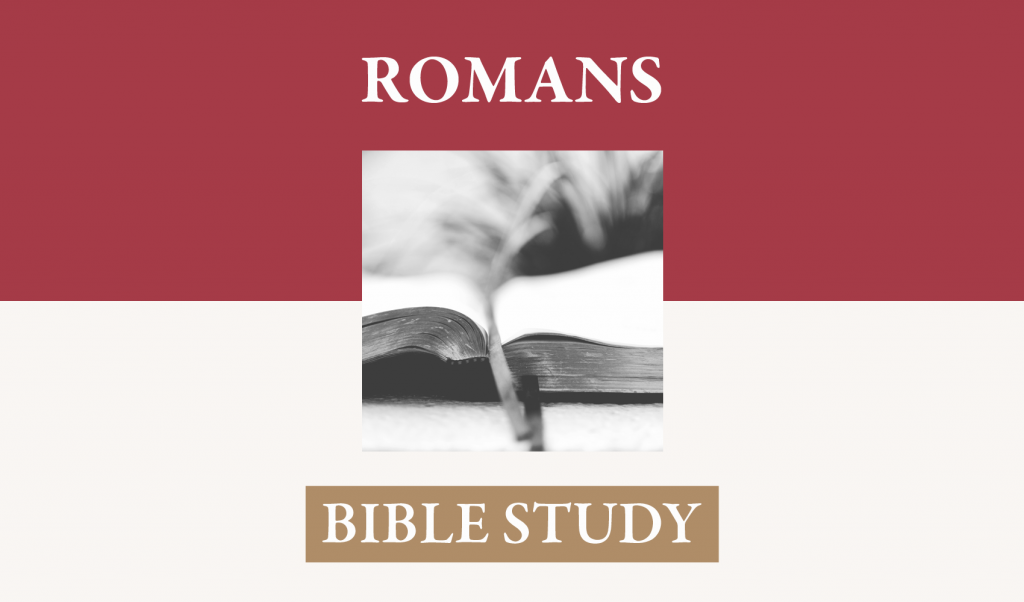This chapter is a critical element of Paul’s argument concerning how the law operates for death in one instance and then as an aid to new life in another. The gospel of forgiveness and justification shows one dimension of the Law; the Spirit’s work in sanctification shows us another dimension. In this chapter Paul travels the rough terrain from the one to the other.
In Chapters 1-3 Paul showed the overarching universal relevance of God’s Law as having brought the entire world under a just condemnation. At the end of chapter 3 he showed that only a divine act of Grace and wisdom could rescue sinners. This must be done in a way that preserved the rightness and equity of the Law as a true and unchangeable reflecton of God’s immutable character and invincible justice [3:24-26]. That made it necessary to show how each aspect of this redemptive work relates to the Law. If the Law is an absolute and has brought all under condemnation [3:19-23] then how are we so thoroughly removed from the sphere of its condemning status over us.
Chapter 4 is given over to the reality that we can never overcome our having broken the Law and achieve salvation by works. Imputation has operated from the first moment of salvation history. No works righteousness is possible for lawbreakers. The Law’s demands are not altered, so a way to come to God while we are ungodly has been brought to fruition, that is by faith. God justifies the ungodly by the way of faith [4:4, 5]. The father of the faithful, Abraham, received righteousness by faith upon believing the promise. The promise was for a Son who would be the conduit of grace unto righteousness for the nations (16). It is not faith itself that constitutes the righteousness imputed to believers, but virtue of their object of faith (4:22-25).
Chapter 5 explains more fully the object of faith and the substance of that which is imputed. The concept of imputation elicits an expanded explanation of the relationship of Christ to the condemning power of the Law, to its demand for righteousness, and how he and we are related to Adam, the source of our original fall into sin and corruption.
Chapter 6 shows that faith secures our connecton with the work of God through Christ, not only in forgiveness and imputation of his obedience, but in the removal of the corrupting power of indwelling sin. Just as surely as condemnation resulted from disobedience, so corruption of heart is one of the penalties we have incurred through Adam. Our personal unrighteousness arises from and also increases the virulence of both corruption and condemnation.
Now in chapter 7, Paul now moves back to the Law to show how it is operative at each stage of the Christian’s experience—its immediate authority over us in all its demands, its rule over us in a new way in Christ, its performing the role of conviction of sin and death to bring us to despair of any hope of saving personal righteousness, and its continuing function in helping root out indwelling sin.
I As long as the Law as a condemning power lives we cannot escape it: Romans 7:1-3 – Paul makes the point that the Law is meant to regulate the conduct of a person while he is alive. He illustrates with the law of marriage. When a man and woman are married to one another, the existence of each stands as a representative of the Law to the other. The wife is a law to the husband, and the husband is a law to the wife. Paul uses the husband as an example of how he is a law to his wife and thus binds her to himself as long as he lives. Should she unite with another man while he is alive and thus still bound to him as law, she is convicted by the law, embodied in the reality of her husband, as an adulteress. When he dies, it is as if that law that binds her to him also dies. It becomes irrelevant in the specific matter of their marriage. His death as the law-bearer means that that specific application of the law has no more power over her. She is now free to marry another without the law of adultery, in the case of that now-dead husband, condemning her.
II. In the application of the illustration, 7:4-6 Christ is both the first husband and the husband of the new life. Christ took within his own body the condemning aspect of the law. All of that which bound us to the law as a condemning factor Christ embodied. As long as Christ lived, the law held its sway over us and condemned us. But Christ died, he “bore our sins in his own body on the tree that we might die to sin and live to righteousness.” [1 Peter 2:24] Christ came into the world, “not to condemn the world but that the world through him might be saved” (John 3:17). His death meant that our marriage to the law that held us under the sentence of death is gone. That law of “sin and die” has no more power over us, for we “have died to the law through the body of Christ” [verse 4]. Now we are married to a new man, the man that no longer embodies the verdict of “sin and die” but the man in whom there is righteousness, reconciliation, eternal life, and a new relation to God. In the former relations every passion, aroused by the Law and operating as an enemy to it, bore fruit for death. That was the Law we lived under—death, and as long as Christ was alive that law held us. Now, however, in Christ’s death, we have died to that which held us captive. Paul focuses on the reality that we are dead to that which held us captive, but he assumes that our death comes as a result of Christ’s death. We are dead to that law since that law died in the death of Christ. When the widow of verse 3 is “free from that law” that means that she is dead to that law. The law as a written code that held for us the verdict of death has been done away with and thus we have died to it. Christ’s resurrection in conjunction with the power of the Spirit of holiness means that we no longer experience the law’s condemnation, but we see it in light of an operation of the Spirit, who also has raised us, in Chist, from spiritual death to spiritual life. [verse 6]
III. How the Law serves the cause of righteousness [7:7,8] The Law functions as an unforgiving master. It does not bend to our weakness and cannot, therefore, declare us righteous. It has no mechanism for compensating for our having fallen short of its demands; it is incapable, therefore, of procuring forgiveness, much less simply granting it. Like the law of marriage, its first relationship to us must die in the body of Christ. Does this mean that the Law in itself is an evil, sinful thing? On the contrary, this very function of being unable to forgive shows how exceedingly sinful sin is and how righteous the Law is. Its threat to kill us and condemn us to eternal punishment is no unrighteous threat. Rather it is the essence of righteousness. The specific demands of the Law show that every aspect of our lives is to be a continual demonstraton of submission to righteousness; if not, we suffer a just condemnation. That law that demonstrates that this is no mere external or lip service to the law, is the commandment, “Thou shalt not covet.” This shows that every desire that is out of bounds, every moment of dissatisfaction, every point of jealousy, or of envy, every lust, every second of forgetting God in the pursuit of self-interest constitutes a violation of God’s standard of righteousness. When that law came alive in the mind of Paul, it opened up to him his utterly destitute condition. The boldness of sin is seen in the graphic language of Paul, “But sn, seizing an opportunity through the commandment” [verse 8, compare with the reiteration of this in verse 11]. A righteous standard came to oppose Paul’s zealous hatred, while the brashness and refusal of the sinful nature to be corrected seized the opportunity to exert its confident independence and lashed out in opposition to that righteous requirement. Without the operation of that utterly righteous standard, Paul could have excused himself, as he actually did, and felt himself to be the model of righteous living, a delusion he actually claimed [Philipians 3:5,6]. But when he saw, that like the Pharisees in the presence of Jesus, inside he was full of dead men’s bones, that the inside of his cup was unwashed and the bearer of filth, he concluded that the verdict of condemnation and death was on him. The law rose up and killed him.
IV. This killing function of the Law is a necessary precursor to conversion and by metaphor an effectual operative in the converting transaction. Romans 7: 9-13 is an apt description of the darkness, deceitfulness, wickedness and subtlety of the flesh. When God opens the human heart to its sinful deformity and captivity to the flesh by having it laid bare by the power of the Word (Hebrews 4:12) and the Law [Romans 7:10],the infinite grotesqueness of any degree of disobedience to that which is holy, righteous, and good inflames the mind with a desperate desire to escape its clutches entirely. The soul, under the effectual convicton of sin by the power of the Word and the Spirit, sees itself justly skewered by the blade of God’s righteous wrath. It dies to self-righteousness; it dies to vain attempts to justify itself by legal obedience. It is at this point in his narrative that Paul is showing his readers the place of the Law, not only in conviction, but in actual conversion. This pivotal description in verses 9-13 is an expansion of Paul’s summary of his conversion in Galatians, “Through the Law I died to the Law that I might live to God” [Gal. 2:19]. That is the story of the man in Romans 7. His conversion is recorded in these words: “When the commandment came, sin became alive and I died [9]. . . . this commandment proved to result in death for me; [10] . . .sin taking opportunity through the commandment, deceived me, and through it killed me [11]….through the commandment sin would become utterly sinful” [13]. All of this confirms that the Law by nature is holy and that each commandment, therefore, is a particular manifestation of that which is holy, righteous, and good. [12] The Law in its nature was designed to confirm humanity in life [10] but by that very trait, through sin, becomes the revelation of death [“sin producing death in me through what is good.”] Now we see that because Christ has embodied, by substitution, that law of sin and death, that only in Him are we free from it and only in Him is God free to declare our freedom from it to be so.
V. Now the Law establishes itself as a friend of true holiness but as an enemy to indwelling sin. Romans 7:14-25. When in Romans 7 does the shift occur from the relationship of the lost person to the law and begin investigating the relationship of the saved person to the law? The following verses, 14-25, follow chronologically describing the now-regenerated, now-justified person’s growing awareness of the depths of indwelling sin and, therefore, his continued absolute dependence on Christ’s having removed the verdict of death. Even in light of the alteration of his mind and heart in regard to the loveliness of the requirements of God’s law, he finds that a principle of struggle with indwelling sin is present. Now, however, his mind is differently disposed toward the law and sin no longer seizes an opportunity through the commandment. All views which do not see this as the experience of the regenerate see verses 14-25 as further exposition of the struggle initiated in verse 7 [“I would not have come to know sin except through the Law”], and manifest in a death struggle in verses 8-13.
Several phrases, however, fail in their impact if asserted for the unregenerate. He “desires” the things of the law and “hates” that which is opposed to it. His intense resistance to his own failings shows that he confesses that the Law is “good,” that is, clearly consistent with and expressive of the holy beauty of God. The person in this struggle knows that good does not live in his flesh for the desire he has for good can not be worked by his flesh [18]. In his former state he gloried in the flesh. He wants the good and does not want the evil [19]. This person serves the law in the inner man [22]. That phrase, “inner man”, in 2 Corinthians 4:16 and Ephesians 3:16 refers to a reality in the regenerate that is the source of spiritual growth and conformity to Christ. The law of his mind, probably synonymous with the inner man, is different from the law in his members. Apparently, this serves as the foundation for Paul’s admonitions in Romans 6 to present their members as instruments of righteousness. This is a person who recognizes the moral disparity between God’s law and the law of sin at work in his flesh [25 and cf Galatians 5:16-18]. The former he serves with his mind. He is not like those of Romans 8:5 who have their minds set on the flesh; rather he has his mind set on the Spirit.
According to those who argue that this person is unregenerate, these descriptions aptly apply to unregenerate Jews who had a high regard for God’s law. That assertion, however, hardly seems to square with Jesus’s presentation of the law as opposed to that of the scribes and pharisees. It was precisely their disregard for the law in both scope and spirituality that brought about his corrective treatment. Apparently they were those who would annul “one of the least of these commandments, and teach others to do the same” [Matthew 5:19]. One’s understanding of the righteousness of the law must exceed that of the scribes and Pharisees or he will not enter the kingsdom of heaven [Matthew 5:20]. When he called them blind guides and hypocrites and accused them of neglecting the weightier matters of the law and said that they were inwardly full of hypocrisy and lawlessness, he would not at the same time say that with their mind they served the law of God or delighted in that law in the inner man.
When Paul lived as a Pharisee, he considered himself blameless concerning the law [Phil 3:6]. The Romans 7 picture is of one whose evaluation of the righteousness of the law is so high that he would never consider himself blameless. Rather he would count all his supposed righteousness as loss. The picture he gives of the Jew’s respect for the law in Romans 2:17-20 does not at all conform with the internal spiritual passion for the law as seen in Romans 7. The Romans 2 picture shows one who approves the law because he is quite confident that possessing it makes him superior to others. While he teaches the Law, he has no understanding as to how many ways he is breaking it. The Romans 7 person has a more profound passion for the spiritual and moral perfection of the law and knows, therefore, that in himself he can claim no degree of conformity to its true demands.
The existential and moral horror of sin increases in the sensitivity of the Christian having the effect of intensifying both repentance and hope. Calvin remarks, “They condemn their sins, not only because they are compelled by the judgment of reason, but because they abhor them with genuine feeling of the heart and detest their conduct in committing sin” (Comm. Rom. 7:15). Of course, that is not all that happens in conversion. But that is an apt description of the converted person’s view of sin. This same person, struggling with sin in chapter 7, is still groaning in chapter 8 with this unfulfilled redemption. While he struggles away from sin, he struggles toward hope, the redemption of his body and his full standing in sonship before the tri-une God (Rom.8:22-25).
VI. Summary: Paul has now come full circle in giving his explanation of how the gospel is the power of God unto salvation even though the wrath of God is revealed.
A. He began the explanation with Law and its unexceptionable condemnation of everyone.
B. In a blindng flash of redemptive grace he set forth Christ as the reconciler of God and man, of grace and wrath. In light of the verdict of the Law how can this be possible?
C. He explained that our failure to perform works of the law means that we must receive gratuitously the righteousness that God gives and the consequent hope of eternal life. Faith is the cordial embracing of the beauty, certainty, and goodness of God’s promise.
D. This righteousness abides only in Christ as the obedient one in whom the one that exhibits faith receives both forgiveness through his blood and righteousness theough his life.
E. Christ’s dealing with the death incumbent upon sin includes a freedom from the corrupting power of sin. We no longer will live in the state of progressive corruption but will live in the state of increasing freedom from sin and holiness in the use of the members of our body.
F. The Law therefore that bound us to death has been killed and so we have been made dead to it; It showed us righteousness by its condemning quality and thus played a part in quickening us so that we may belong to another, to embrace the risen Christ. That same law that killed, and showed us Christ as the only source of righteousness, now has the friendly function of helping us sort out the deep presence of indwelling sin. Before it pointed us to Christ for righteousness; now it points us to the Spirit for mortification of the flesh and motivation of hope.





















